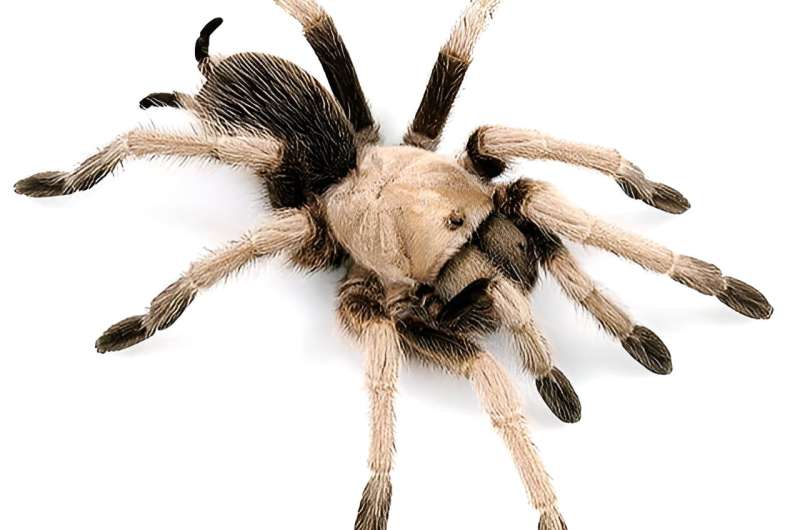Spiders, spiders everywhere? Tarantula mating season starts early amid threats to arachnids

It's tarantula season in the golden hills of the Bay Area: that period every fall when black, hairy males of the species Aphonopelma iodius emerge from their underground burrows in search of a receptive female—a first and final act of carnal exploration before they die.
On a recent weekday evening, a group of Sierra Club members met before sunset at Mount Diablo State Park in Walnut Creek in hopes of witnessing a few of these desperate, single-minded, eight-legged prowlers.
"They said they saw 18 on a hike last week," said Ken Lavin, a naturalist at the state park and former National Park ranger at Muir Woods and Marin Headlands. "I doubt it, though; they probably just kept crossing paths with the same ones. I think we'll be lucky if we see one."
Lavin—who's been leading these tours for roughly 25 years—said male tarantulas are coming out earlier in the season than they used to, and in fewer numbers. By the end of the two-hour hike that evening, three lusty male tarantulas had been spotted.
Historically, the mating season has fallen between late September and early October, but Lavin said it's now starting in August.
He said that may be related to climate change—hypothesizing that insects are more active in higher temperatures—but it might be due to something else. Either way, it's clear things have changed.
Lavin's observations are not unique, said Jason Bond, a spider researcher at UC Davis. He's heard similar reports.
The problem is that "there's just no good baseline data" for biologists and wildlife officials to gauge how climate change is affecting wild spider populations, Bond said.
It's a problem that's plagued researchers in recent years as anecdotal information about population crashes in insect and spider populations have been reported. Unlike birds, mammals or fish—for which there is generally good, long-term data on population and range—insects and spiders have been pretty well ignored.
"There are many species that we've described—that I've worked on—that, if you were using the [International Union for Conservation of Nature] Red List criteria, they'd be designated as threatened or endangered," Bond said, adding that "a number of species ... are now extinct," and exist only in museum collections.
Two of them, he said, were trapdoor spider species in Dana Point and Palm Springs that were wiped out by the construction of golf courses.
The International Union for Conservation of Nature has no invertebrates on its Red List, although it is looking to include them in the future—prioritizing certain taxonomic groups including "bumblebees, monarch butterflies, swallowtail butterflies, freshwater crustaceans, dragonflies, velvet worms, giant clams, abalones, sea urchins" and "selected families of spiders, scorpions, and grasshoppers."
The situation is concerning, Bond said, considering how important spiders are for healthy, functioning ecosystems. They not only keep insect populations in check, but they provide sustenance for animals such as birds and mammals.
And, he said, they're really cool.
Some spiders, he said, form aggregations and cooperate in brood care—in which adult spiders care for other spiders' offspring. Others appear to participate in lekking behavior, in which two or more males will perform for a female—duking it out through courtship displays—to gain her favor.
Then there's the portia spider—a kind of jumping spider—which appears to use trial and error when faced with new kinds of prey, and then seems to remember what worked when faced with similar prey.
Asked if spiders have brains, or neuronal circuity more like that of octopuses, Bond laughed, and said that while they have a centralized ganglion up in the front part of the face, "you probably don't want to over-glamorize their intelligence."
They're no octopuses, he said, but that doesn't mean spiders aren't worthy of our awe, respect and protection.
Aside from Australia, California has the world's highest diversity of trapdoor spiders—a type similar in appearance to tarantulas—and they're nearly everywhere that hasn't been paved over, built upon or excavated, Bond said.
"You ever been to the beach and sat on a sand dune?" he asked. "You were probably right next door to one."
Like tarantulas, trapdoor spiders burrow into the ground, where they hang out waiting for prey to approach on the ground above. While tarantulas wait below with their eight eyes pointed skyward, trapdoor spiders build a webbed door and fling it open when the unsuspecting prey walks by.
They're also really good moms, Bond said. "Oftentimes they'll have a brood of spiderlings that are hanging out in the burrow, getting fed by Mom, sometimes for more than a year," he said. He's even found a "couple of larger juveniles, the kind of teenagers that won't leave," in a few cases.
But typically, "once everybody reaches maturity, they'll leave the burrow and wander out; find a place to make their burrow," he said.
And that's in part why they are of particular conservation concern, Bond said, "They don't get very far ... or disperse really great distances."
Many spiders use their webbing to create balloons or parachutes that allow them to float away—sometimes traveling many miles.
Trapdoor spiders and tarantula spiderlings tend to disperse by walking, Bond said, "so if the habitat gets destroyed or messed up, perturbed in some way, they're really limited [in] ... how far they can go."
Genetic analyses bear this out: The difference in the genomes of trapdoor spider species living just a few miles apart is often greater than that between a human and a chimp, he said.
Trapdoor spiders were probably once distributed across the entire Los Angeles Basin, Bond said. "Of course, now they are all extinct."
He said that if they were spider monkeys instead of spiders, that devastation would "have been on the front page of every newspaper."
"It pains me because they are incredibly beautiful animals," he said. "They deserve the same level of protection."
Journal information: ZooKeys
2023 Los Angeles Times. Distributed by Tribune Content Agency, LLC.
No comments:
Post a Comment